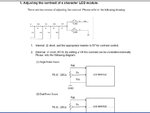mariuszoll
Member level 5
Hi,
I use on my project a LCD PC1602-H from PowerTip. I connected Vo to GND, but I can barely see what is displayed on the display. The software works well.
I read on forums that the LCD works well with Vo connected to -1.2V.
Could you help me please with some ideas of getting this negative voltage with only discrete components?
I'm looking forward to hearing from you.
Thank you in advance.
I use on my project a LCD PC1602-H from PowerTip. I connected Vo to GND, but I can barely see what is displayed on the display. The software works well.
I read on forums that the LCD works well with Vo connected to -1.2V.
Could you help me please with some ideas of getting this negative voltage with only discrete components?
I'm looking forward to hearing from you.
Thank you in advance.


